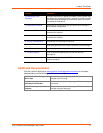
2: Overview
SLB™ Branch Office Manager User Guide 14
Typical Equipment
You can configure, administer, and manage IT equipment in a variety of ways, but most
devices have one method in common: an RS-232 serial port, sometimes called a
console, auxiliary, or management port. These ports are often accessed directly by
connecting a terminal or laptop to them, meaning that the user must be in the same
physical location as the equipment. SLB devices give the user a way to access them
remotely from anywhere there is a network or modem connection.
The SLB can access and administer many types of equipment, such as:
Servers: Unix, Linux, Windows 2003, and others
Networking equipment: Routers, switches, storage networking
Telecom: PBX, voice switches
Other systems with serial interfaces: Heating/cooling systems,
security/building access systems, UPS, medial device.
Types of Business
The SLB branch office manager is used in many types of business, for example:
Banking and finance
Insurance companies
Healthcare
Retail Sales
Information Technology
Education and campus style facilities
Hospitality
Manufacturing Facilities
Benefits
The key benefits of using the SLB branch office manager:
Saves space: Compact design merges the functionality of three solutions into a
1U rack solution, reducing required rack space and total cost of ownership.
Saves money: Enables remote management and troubleshooting without
sending a technician onsite, resulting in reduced travel costs and increased
network uptime.
Saves time: Provides instant access and reduces response time, improving
efficiency.
Simplifies access: Enables 24/7 access to your equipment securely and
remotely after hours and on weekends and holidays—without having to schedule
visits or arrange for off-hour access.
Protects assets: Provides the highest levels of encryption and security features
(authentication, authorization, and IP filters) to ensure that your IT infrastructure
and data assets are protected.


















